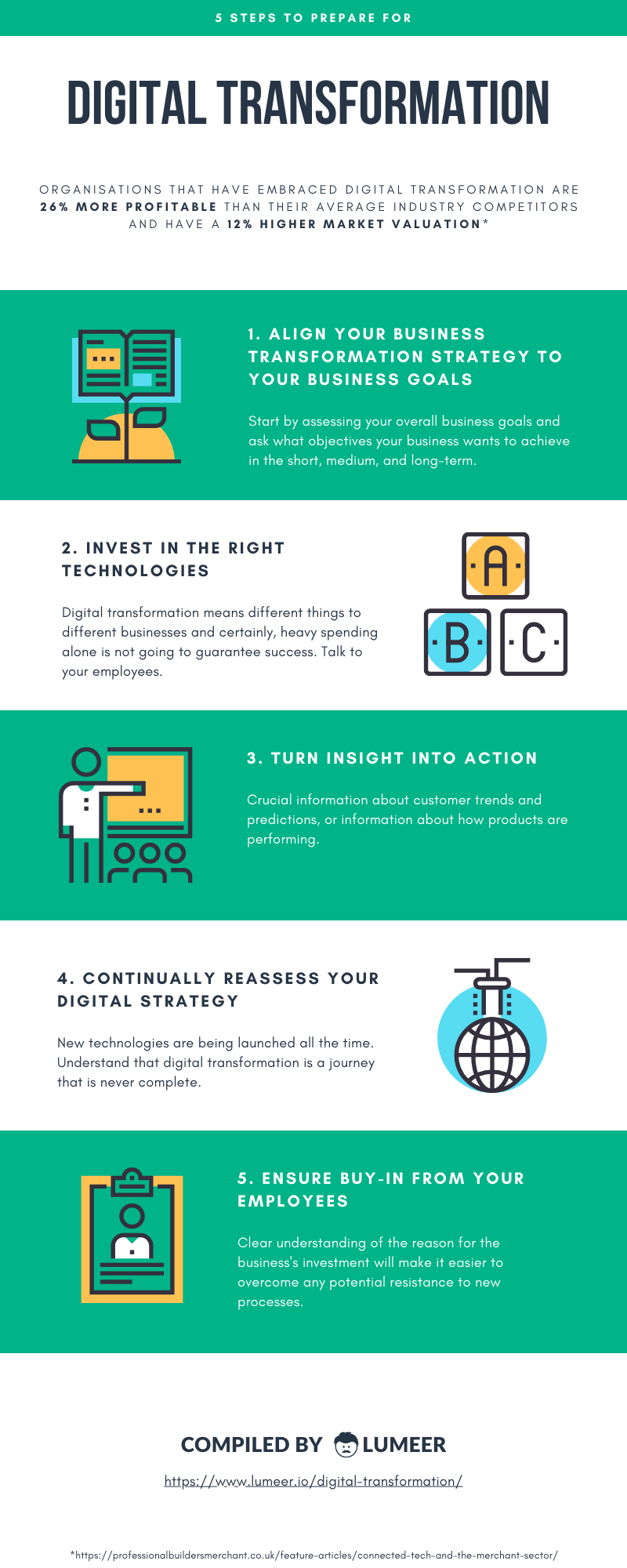Digital Transformation: Why it is Important and How to Get Ready?

In today’s business environment, adopting digital strategies and processes is more than an afterthought. To stay relevant and competitive, organizations must begin and process their digital transformation transition.
However, digital transformation is not only about adopting new technology. It must be ingrained into the core business processes and values and should be championed by leadership to have maximum impact.
In this article, we will focus on what digital transformation is and why it is important for organizations.
Written by our guest blogger Yogesh Daga.
What is Digital Transformation?
Often digital transformation is perceived as the implementation of digital technologies to build relationships and to better understand customer needs.
But this is only one way to look at it. It also includes discovering new growth opportunities, finding new revenue streams, and pushing your business towards innovation. Digital transformation is about finding new possibilities of existing business services to deliver effective customer experience.
Yet, for many organizations, digital transformation becomes more of a concept rather than an actual part of business processes. This is because companies tend to believe that any disruption in the business processes will lead to problems in sales, support, and other areas of operations.
What Drives Digital Transformation?
Digital transformation is mainly driven by three important factors working in tandem with each other. These includes
- Innovative technology
- Customer behavior
- External factors
Innovative technology helps in disrupting business operations by delivering efficient results at a lower cost, faster speed, and minimal effort.
This disruption in technology changes customer behavior, expectations, and demands. The newly created demand introduces external factors in the market such as new competition and regulatory factors.
For instance, the innovative on-demand ride-sharing technology of Uber disrupted the transportation industry. It made the customer experience much smoother and efficient.
This in return changed the customer expectations forever, as people now prefer on-demand taxi services rather than traditional taxi services.
Why is Digital Transformation Important?
According to a recent report, the worldwide spending to enable digital transformation is forecasted to reach $2.3 trillion in 2023. From 2019 to 2023, the spending is expected to grow at a compound annual growth rate (CAGR) of 17.1%.
This shows that technology is no longer a choice. It is a must-have strategy that has to be interwoven with other business initiatives.
The following are the reasons why digital transformation plays an important role in the growth of your business.
1. Customer Expectations Are On the Rise
Amazon, Netflix, and Uber are to blame for rising customer expectations. From one-day delivery to on-demand videos and taxis, customers are increasingly getting exposed to an improved digital experience.
Therefore, if your business is not able to meet the rising demand and expectations, it stands to lose a large chunk of customer base and thus revenue. In simple words, if you decide to ignore digital transformation, you are risking losing the entire business.
2. Helping Employees Get More Effective
Technological advancements help employees to do their job more effectively and productively. Digital trends provide organizations with an opportunity to move away from manual processes and automate key business operations.
For instance, in the finance department, technology can automate manual processes such as invoice tracking and payroll. This will allow employees and leaders to focus on new business opportunities.
Overall, employees are motivated by productivity and then need to know what to do next, why it is important, and how to do it. This is where a tool like Work Operating System plays a key role.
3. Data-backed Decision Making
It is simple: If you cannot measure it, then you cannot manage it. For ensuring that your business is functioning at its peak, you need to have numbers and data for comparing it against industry benchmarks.
Leveraging the power of big data and AI-based technologies will provide you with accurate and timely insights. These business insights can then be used to optimize business processes and strategies for superior results.
All employees take responsibility and participate in the decision making process. New digital tools enable them to run ad hoc reports and be ready for new responsibilities.
4. Better Market Penetration
One way to grow your business is to tap the unexplored market and add new customers. Using digital technology helps in identifying target customers and segmentation based on demographics, interest, and other key indicators.
Digital transformation makes the entire market penetration process much simpler, allowing you to enter the market at an early stage and to gain first-mover advantage.
If your business does not effectively penetrate the untapped market, it risks losing new and potential customers to your competition.
How Companies (Including Corporations) Handle the New Demands?
To meet shifting customer expectations, companies including corporations are focusing on data, culture, and innovation to drive digital transformation.
For instance, Hasbro – one of the iconic toymakers in the world – realized that it has been focusing its advertising effort on children rather than on parents who buy the products. Through leveraging the power of data and analytics, Hasbro transformed its advertising efforts and focuses on different marketing channels to reach its target audience.
The toymaker is now focusing on parents with their ads on social media platforms because they buy the toys for their children. This is proving quite fruitful for the company. After increasing its ad spend, the company was able to increase its sales by nearly $1 billion, reaching $5 billion in sales in 2016.
Another corporation that handled digital transformation successfully is SAP. The organization believes that company culture is equally important as that of technology and processes.
Rather than bringing outside expertise, SAP provided their employees with the necessary tools to learn, adapt, change, and embrace their skill sets on their own. Although it was time-consuming, it meant the employees were adopting a hands-on approach for the future.
In addition to this, SAP also created a culture of embracing failure rather than seeing it as negativity. SAP created an environment that focuses on learning and evolving from failure rather than blaming each other for shortcomings. Prioritizing culture allowed SAP to successfully handle the digital transformation.

What Are the Risks If Companies Decide to Ignore Digital Transformation?
The best way to understand the risk of ignoring digital transformation is to think about how one company killed the entire retail industry. There was nothing that suggested risk to the retail industry 15-20 years ago. In 2005, Amazon was just an online bookseller with modest sales figures.
However, in July 2020, the market capitalization of Amazon was $1.5 trillion, much more than any other brick and mortar names in the United States. Moreover, with the recent outbreak of coronavirus makes digital transformation even more important.
While several retailers such as JC Penny closed down several stores across the United States, Amazon on the other hand increased their market value by more than $600 billion in 2020 alone. This shows what companies stand to lose by ignoring digital transformation.
How to Create a Digital Transformation Action Plan in Your Company?
The following are the points that serve as a guide in developing a strategic action plan in your company.
1. Define Business Objectives
One of the reasons why digital transformation fails is that companies focus on the implementation of technologies. Instead, the focus should be on how technologies will help in achieving business objectives.
Determine what the business hopes to achieve through digital transformation and then chose the right technology.
2. Invest In the Right Technology
Most importantly, involve all employees to understand what works.
There is no one-size-fits-all digital transformation plan. What works for your organization might not work for another and vice versa.
Moreover, one of the other reasons why digital transformation fails is that the opinion of employees who are regularly using the technology are not sought. Therefore, gather insights from employees and research workflow processes before deciding to implement any technology.
3. Turn Insight into Action
Crucial information about customer trends and predictions, or information about how products are performing, need to be evaluated constantly and corrective steps must be taken as frequently as possible (and reasonable).
Document the risks. There is a risk associated with everything, and digital transformation is no different. Therefore, it is prudent that you discuss, analyze, and document these risks to track them over a specified period.
4. Run a Pilot Test
Having a proof-of-concept is important before implementing an organization-wide digital transformation. Run a pilot test and identify the impact on your employees, culture, and business overall.
This will ensure that your employees and organization are ready to move forward and implement digital transformation successfully.
5. Prepare For Culture Change
The most important aspect of digital transformation is the cultural change in your organization. Overlooking this will be the biggest mistake one can make. Therefore, give careful consideration and see how the people in your organization are affected by it.
Conclusion
Digital transformation is the need of the hour. With the changing customer preferences and expectations, organizations must get on the digital bandwagon to offer the best possible experience.
Moreover, with the ever-changing business landscape, adopting digital transformation helps the business to stay relevant and competitive in the market.
Besides that, it also opens new business opportunities for corporations to drive their market growth.
Do your fist step and try Lumeer now.
